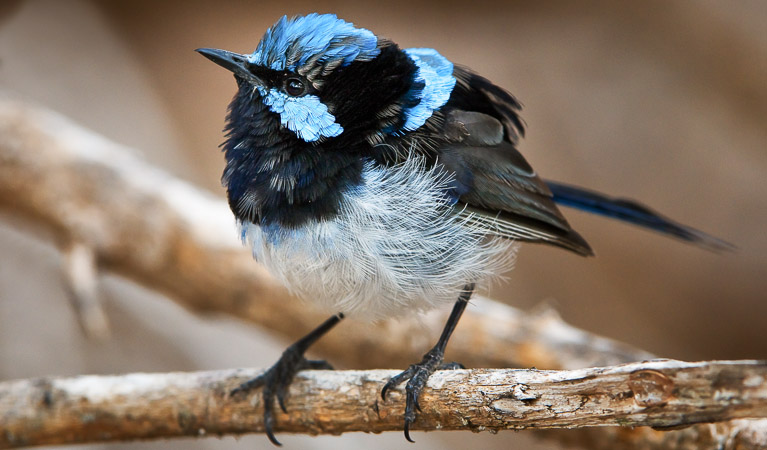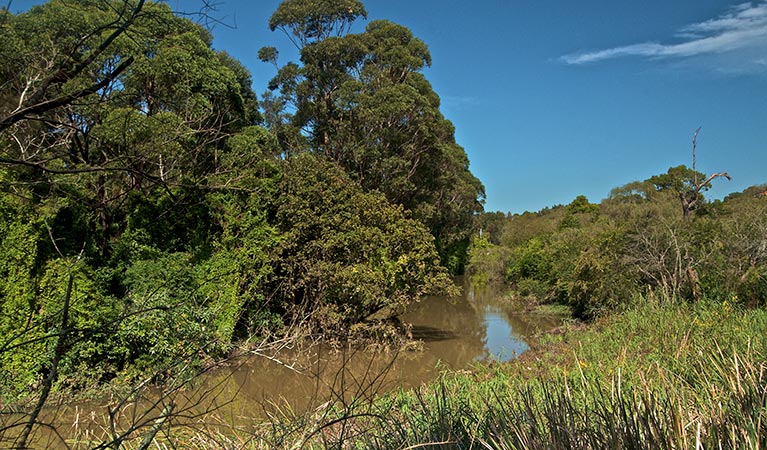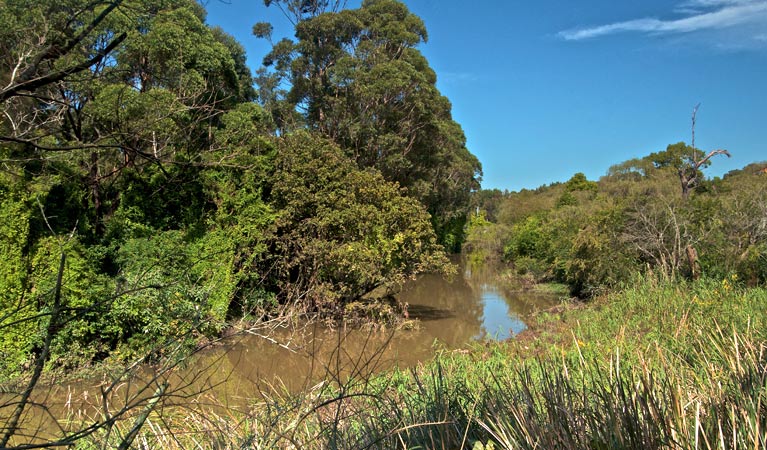Wolli Creek walking track
Wolli Creek Regional Park
Overview
It’s such a treat to be able to take a bushwalk in the city. Look out for the amazing birdlife and enjoy the serenity of this short and easy walk.
- Accessibility
- Hard
- Distance
- 2km one-way
- Time suggested
- 20 - 30min
- Grade
- Grade 3
- What to
bring - Hat, drinking water, sunscreen
- Please note
- If you feel like a longer day walk, you can take the Two Valley trail from Campsie to Bexley North – it’s 13km in length, but there are some good places to stop for a coffee along the way
- Girrahween picnic area at the Bardwell Park end of the walk is a good place to stop for a picnic or barbecue
Wolli Creek walking track is a 2km section of the Two Valley trail, linking Campsie to Bexley North via a riverside trail that passes through Canterbury, Undercliffe and Bardwell Park. The park is a very special area, forming a vital vegetation corridor that assists native plants to survive because of its dense bush habitat for the insects and birds that pollinate the plants.
If you live in the local area, this short track is great for a brisk morning walk. Early morning and dusk are good times to spot the local wildlife; look for Australian pelicans hunting for fish, egrets with their long necks and tawny frogmouths camouflaged in the trees.
If you don’t live in the area, you can easily access this peaceful walk from one of the train stations along the route, including Turella, Bardwell Park, and Bexley North. The longer Two Valley trail can be accessed from a number of points along its 13km.
Map

Map legend

Local alerts
For the latest updates on fires, closures and other alerts in this area, see https://uat.nswparks.cloud/things-to-do/walking-tracks/wolli-creek-walking-track/local-alerts
General enquiries
- National Parks Contact Centre
- 7am to 7pm daily
- 1300 072 757 (13000 PARKS) for the cost of a local call within Australia excluding mobiles
- parks.info@environment.nsw.gov.au
Park info
- in Wolli Creek Regional Park in the Sydney and surrounds region
Wolli Creek Regional Park is always open but may have to close at times due to poor weather or fire danger
Visitor info
All the practical information you need to know about Wolli Creek walking track.
Maps and downloads
Learn more
Wolli Creek walking track is in Wolli Creek Regional Park. Here are just some of the reasons why this park is special:
Bird haven

Wolli Creek Regional Park is an important habitat for a variety of birds. Look for cormorants and darters as you're walking by the creek and keep an eye out for blue wrens and finches on the edge of the open lawns. In the sky you may catch a glimpse of brown goshawks and peregrine falcons on patrol.
- Wolli Creek walking track It’s such a treat to be able to take a bushwalk in the city. Look out for the amazing birdlife and enjoy the serenity of this short and easy walk.
Stretch your legs in the city

Just because you live in the city, it doesn’t mean you can’t enjoy the bush. Go for a run, take a leisurely stroll with the dog or let the kids burn off some energy on the trails and in the play areas. Wander the Wolli Creek walking track with its sandstone cliffs or walk the entire Two Valley trail. There are also several gorgeous spots around Wolli Creek Regional Park to meet family and friends for a barbecue or picnic. Relax on a rug while the kids play at the playground at Turrella Lawns or enjoy a quiet family picnic in the shade at Girrahween picnic area.
- Girrahween picnic area Enjoy a barbecue and laze under the trees at Girahween picnic area in Wolli Creek and leave the hustle and bustle of the city behind.
Plants and animals protected in this park
Animals
-

Grey-headed flying-fox (Pteropus poliocephalus)
The grey-headed flying fox is Australia's largest native bat, with a wingspan up to 1m. This threatened species travels up and down south-eastern Australia and plays a vital role in pollinating plants and spreading seeds in our native forests.

